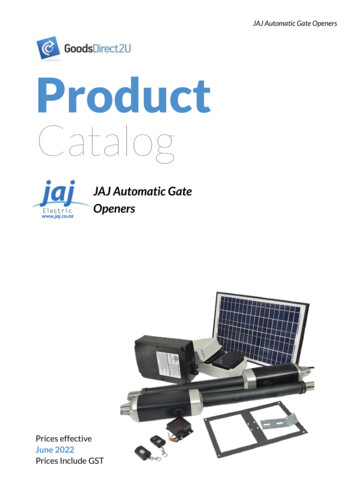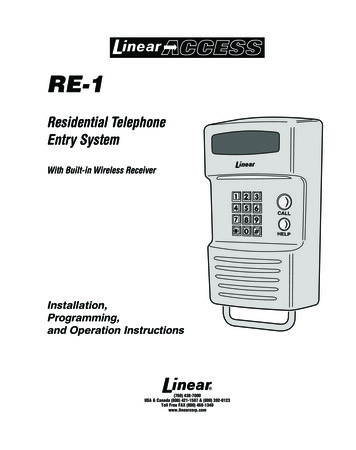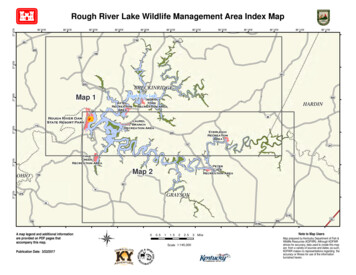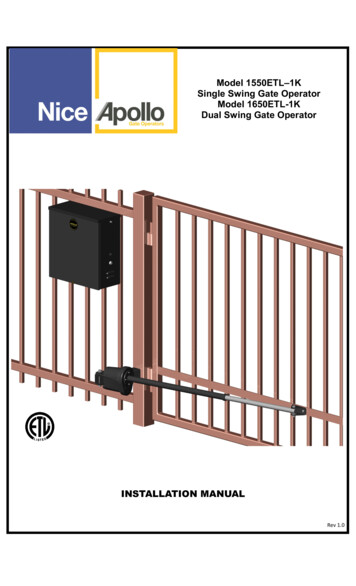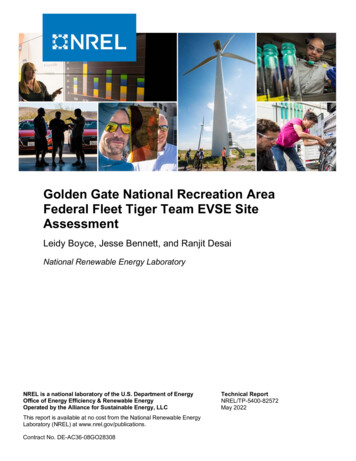
Transcription
Golden Gate National Recreation AreaFederal Fleet Tiger Team EVSE SiteAssessmentLeidy Boyce, Jesse Bennett, and Ranjit DesaiNational Renewable Energy LaboratoryNREL is a national laboratory of the U.S. Department of EnergyOffice of Energy Efficiency & Renewable EnergyOperated by the Alliance for Sustainable Energy, LLCThis report is available at no cost from the National Renewable EnergyLaboratory (NREL) at www.nrel.gov/publications.Contract No. DE-AC36-08GO28308Technical ReportNREL/TP-5400-82572May 2022
Golden Gate National Recreation AreaFederal Fleet Tiger Team EVSE SiteAssessmentLeidy Boyce, Jesse Bennett, and Ranjit DesaiNational Renewable Energy LaboratorySuggested CitationBoyce, Leidy, Jesse Bennett, and Ranjit Desai. 2022. Golden Gate National RecreationArea Federal Fleet Tiger Team EVSE Site Assessment. Golden, CO: National RenewableEnergy Laboratory. NREL/TP-5400-82572. https://www.nrel.gov/docs/fy22osti/82572.pdf.NREL is a national laboratory of the U.S. Department of EnergyOffice of Energy Efficiency & Renewable EnergyOperated by the Alliance for Sustainable Energy, LLCTechnical ReportNREL/TP-5400-82572May 2022This report is available at no cost from the National Renewable EnergyLaboratory (NREL) at www.nrel.gov/publications.National Renewable Energy Laboratory15013 Denver West ParkwayGolden, CO 80401303-275-3000 www.nrel.govContract No. DE-AC36-08GO28308
NOTICEThis work was authored by the National Renewable Energy Laboratory, operated by Alliance for SustainableEnergy, LLC, for the U.S. Department of Energy (DOE) under Contract No. DE-AC36-08GO28308. Fundingprovided by the U.S. Department of Energy Office of Energy Efficiency and Renewable Energy Federal EnergyManagement Program. The views expressed in the report do not necessarily represent the views of the DOE or theU.S. Government.This report was prepared by Alliance for Sustainable Energy, LLC, as an account of work sponsored by DOE.Neither DOE, Alliance for Sustainable Energy, LLC, nor any of their employees, make any warranty, express orimplied, or assume any legal liability or responsibility for the accuracy, completeness, or usefulness of anyinformation, apparatus, product, or process disclosed, or represents that its use would not infringe privately ownedrights. Reference herein to any specific commercial product, process, or service by trade name, trademark,manufacturer, or otherwise does not necessarily constitute or imply its endorsement, recommendation, or favoringby DOE or Alliance for Sustainable Energy, LLC. The views and opinions of authors expressed herein do notnecessarily state or reflect those of DOE, the U.S. Government, or Alliance for Sustainable Energy, LLC.This report is available at no cost from the National RenewableEnergy Laboratory (NREL) at www.nrel.gov/publications.U.S. Department of Energy (DOE) reports produced after 1991and a growing number of pre-1991 documents are availablefree via www.OSTI.gov.Cover Photos by Dennis Schroeder: (clockwise, left to right) NREL 51934, NREL 45897, NREL 42160, NREL 45891, NREL 48097,NREL 46526.NREL prints on paper that contains recycled content.
List of AcronymsBEVbattery electric vehicleEOexecutive orderEVelectric vehicleEVI-LOCATEelectric vehicle infrastructure localized charging assessment tool andestimatorEVSEelectric vehicle supply equipmentFASTFederal Automotive Statistical ToolFEMPFederal Energy Management ProgramGOGAGolden Gate National Recreation AreaGOVgovernment-owned vehicleGSAU.S. General Services AdministrationHDVheavy-duty vehicleLDVlight-duty vehicleMDVmedium-duty vehiclePHEVplug-in hybrid electric vehiclePOVprivately owned vehicleS&SWsedans and station wagonsSAESociety of Automotive EngineersSINstandard item numberSUVsport utility vehicleZEVzero-emission vehicleZPACZero Emission Vehicle Planning and Charging tooliiiThis report is available at no cost from the National Renewable Energy Laboratory at www.nrel.gov/publications.
Table of Contents12345Introduction . 11.11.2Electric Vehicle Supply Equipment Tiger Teams . 1Site Overview . 22.12.22.32.42.52.6Existing Infrastructure Projects . 4Zero-Emission Vehicle Planning and Charging Analysis . 4Workplace Charging Needs. 6Electric Vehicle Supply Equipment Deployment Needs. 6Parking Layout at Sites . 6Electric Vehicle Supply Equipment Installation Design Guidelines . 93.13.23.33.4Fort Mason Option A: Fleet Vehicles Only . 10Fort Mason Option A: Cost Estimate . 11Fort Mason Option B: Workplace Charging . 12Fort Mason Option B: Cost Estimate . 134.1Fort Cronkhite Option A: Kirkpatrick Street. 145.1Next Steps . 18Fleet Electrification Planning . 3Electric Vehicle Supply Equipment Installation Planning at Fort Mason . 10Electric Vehicle Supply Equipment Installation Planning at Fort Cronkhite . 14Tiger Team Recommendations . 18References . 19Appendix A.GOGA’s Vehicle Inventory . 20ivThis report is available at no cost from the National Renewable Energy Laboratory at www.nrel.gov/publications.
List of FiguresFigure 1. GOGA’s vehicle fleet composition . 2Figure 2. ZEV acquisition planned by GOGA as of December 20, 2021 . 3Figure 3. ZPAC summary results as of December 20, 2021 . 5Figure 4. Fort Mason current parking lot layout . 7Figure 5. Fort Cronkhite Kirkpatrick Street parking. 8Figure 6. Fort Cronkhite Building 1046 parking lot . 8Figure 7. Fort Mason Option A EVSE deployment outline . 11Figure 8. Fort Mason Option B EVSE deployment outline . 12Figure 9. Fort Cronkhite Option A EVSE deployment outline . 15Figure 10. Fort Cronkhite Option B EVSE deployment outline . 17List of TablesTable 1. GOGA’s Priority Sites for Charging Infrastructure . 3Table 2. Proposed Electric Service Upgrades at Buildings of Interest . 4Table 3. Potential EV Candidates Based on ZPAC Results. 5Table 4. Existing EVSE Units at Priority Sites . 6Table 5. SAE J1772 AC Charging Options . 9Table 6. EVSE Deployment Options at Fort Mason . 10Table 7. Fort Mason Option A EVSE Installations. 11Table 8. Fort Mason Option A Conduit Raceway/Trenching Distances. 12Table 9. Fort Mason Option B EVSE Installations . 13Table 10. Fort Mason Option B Conduit Raceway/Trenching Distances . 13Table 11. EVSE Deployment Options at Fort Cronkhite . 14Table 12. Fort Cronkhite Option A EVSE Installations . 15Table 13. Fort Cronkhite Option A Conduit Raceway/Trenching Distances . 16Table 14. Fort Cronkhite Option B EVSE Installations. 17Table 15. Fort Cronkhite Option B Conduit Raceway/Trenching Distances. 17Table 16. Minimum Recommended Fort Mason EVSE Installations by Site . 18Table A-1. GOGA’s Full Vehicle Inventory as of December 2020 . 20vThis report is available at no cost from the National Renewable Energy Laboratory at www.nrel.gov/publications.
1 IntroductionThe U.S. Department of Energy Federal Energy Management Program (FEMP) helps federalagencies reduce petroleum consumption and increase alternative fuel use through its resourcesfor the Sustainable Federal Fleets program. A key element of this assistance involves supportingagencies in the transition to zero-emission vehicles (ZEVs), including battery electric vehicles(BEVs) and plug-in hybrid electric vehicles (PHEVs). The White House has established a policyfor the federal fleet to lead by example and accelerate the transition to electric transportationthrough two executive orders (EOs)—EO 14008: Tackling the Climate Crisis at Home andAbroad (signed on January 27, 2021) and EO 14057: Catalyzing America’s Clean EnergyIndustries and Jobs through Federal Sustainability (signed on December 8, 2021).EO 14008 establishes the policy of the current administration to “organize and deploy the fullcapacity of its agencies to combat the climate crisis.” Specifically, EO 14008 calls on allagencies to transition to ZEVs.EO 14057 further details the EO 14008 policy by requiring, in Section 102 (a)(ii), that eachagency ensure that all light-duty vehicle (LDV) acquisitions are ZEVs by fiscal year (FY) 2027and that all vehicle acquisitions are ZEVs by the end of FY 2035. To support the transition of thefederal fleet to ZEVs, Section 201 requires agencies to work with the White House Council onEnvironmental Quality and the Office of Management and Budget to propose and establishtargets for the annual (FY 2022 and onward) acquisition of ZEVs and the deployment ofcharging infrastructure. Key to this effort is the requirement to annually update a ZEV fleetstrategy that includes “optimizing fleet size and composition; deploying [ZEV] refuelinginfrastructure; and maximizing acquisition and deployment of zero-emission light-, medium-,and heavy-duty vehicles where the General Services Administration (GSA) offers one or moreZEV options for that vehicle class.”In developing and implementing their ZEV fleet strategies, agencies should focus on evaluatingelectric vehicle (EV) deployment opportunities at individual fleet locations, which have uniquesite, vehicle operating, and utility service characteristics. This is best achieved through siteassessments to evaluate opportunities for ZEV acquisitions, identify optimal ZEV candidates,and determine optimal electric vehicle supply equipment (EVSE) deployment strategies.This site report supports the development of a ZEV deployment plan for the Golden GateNational Recreation Area (GOGA), which can ultimately be incorporated into the overall U.S.Department of the Interior ZEV fleet strategy.1.1 Electric Vehicle Supply Equipment Tiger TeamsFEMP offers technical assistance to agencies developing fleet electrification goals, includingplanning for charging infrastructure, through EVSE Tiger Teams. Tiger Teams include NationalRenewable Energy Laboratory engineers and fleet experts who review site ZEV acquisitionopportunities and EV charging needs and develop ZEV acquisition and EVSE installationrecommendations that minimize costs while accommodating long-term charging needs.1This report is available at no cost from the National Renewable Energy Laboratory at www.nrel.gov/publications.
1.2 Site OverviewThe Tiger Team provided 2020 fleet data to GOGA from the Federal Automotive Statistical Tool(FAST) that showed an inventory of 177 vehicles, including 172 GSA-leased vehicles and 5vehicles that are agency-owned. Figure 1 provides a breakdown of GOGA’s fleet by vehicletype. The majority of the fleet—65%, or 114 vehicles—comprises LDVs, which are the focus for2022 EV acquisitions. The remainder of the fleet primarily consists of medium-duty vehicles(MDVs)— 29%, or 51 vehicles—with the remaining 6% split between heavy-duty vehicles(HDVs) and vehicles that are not reported in FAST. Currently, 13 of the 114 LDVs are ZEVs,including 4 BEVs and 9 PHEVs. Because electric LDVs are more commonly available throughthe GSA, this poses an excellent opportunity for GOGA to electrify the remaining 111 LDVs.Figure 1. GOGA’s vehicle fleet composition2This report is available at no cost from the National Renewable Energy Laboratory at www.nrel.gov/publications.
2 Fleet Electrification PlanningGOGA’s vehicle acquisition plan for FY 2022 includes the replacement of 10 vehicles, with 3 ofthose replacements planned as BEVs. In addition to the FY 2022 acquisitions, GOGA hasplanned for up to 69 ZEV acquisitions throughout the next 5 years, as shown in Figure 2. Thisvision for fleet electrification requires additional electrical charging infrastructure beyond theexisting seven EVSE ports available throughout GOGA’s facilities. The EVSE Tiger Teamsupported the evaluation of new electrical charging infrastructure at Fort Mason and FortCronkhite to support the rapid expansion of BEVs and PHEVs planned at those locations, asdetailed in Table 1.Figure 2. ZEV acquisition planned by GOGA as of December 20, 2021Table 1. GOGA’s Priority Sites for Charging InfrastructureFort MasonBuilding 201Fort CronkhiteBuilding 1056Fort CronkhiteBuilding 1062Fort CronkhiteBuilding 1065Existing EVSE ports5002Planned ZEVs262105Remaining vehicles70323This report is available at no cost from the National Renewable Energy Laboratory at www.nrel.gov/publications.
2.1 Existing Infrastructure ProjectsIn addition to the rapid electrification plans, GOGA is currently pursuing multiple serviceupgrade projects at both Fort Cronkhite and Fort Mason. Fort Cronkhite is planning to upgradethe electric service at a series of buildings to support the installation of new heat pumps as part ofa building electrification effort. The building electrification plans were developed in coordinationwith the utility Pacific Gas and Electric Company and include additional capacity to support theinstallation of new EVSE. Unlike at Fort Cronkhite, the distribution equipment at Fort Mason iscurrently owned and operated by GOGA; however, Fort Mason is currently undergoing adistribution upgrade project for Pacific Gas and Electric Company to own and operate thedistribution circuits throughout the area. As part of this project, the transformers servingbuildings 201 and 204 are being upgraded and will have the capacity to support EVSE. Table 2details the proposed electric service panels at each location, with the estimated spare capacity ineach as provided by GOGA. These ongoing electrical upgrade efforts are well timed withGOGA’s fleet electrification plans and will support the installation of fleet EVSE by reducingthe need to support electric service and distribution upgrades.Table 2. Proposed Electric Service Upgrades at Buildings of InterestBuildingNew Service Panel RatingFort CronkhiteBuilding 1066200 A, 120/240 VFort CronkhiteBuilding 1067200 A, 120/240 VFort CronkhiteBuilding 1068200 A, 120/240 VFort CronkhiteBuilding 1069200 A, 120/240 VFort CronkhiteBuilding 1070200 A, 120/240 VFort MasonBuilding 201600 A, 208Y/120 VFort MasonBuilding 204200 A, 120/240 VSpare Capacity (A)200100100100100291852.2 Zero-Emission Vehicle Planning and Charging AnalysisIn addition to the FAST data, the Tiger Team shared the ZEV Planning and Charging (ZPAC)tool with GOGA. ZPAC helps federal agencies identify ZEV candidates based on vehiclemission and parking location. GOGA evaluated 177 fleet vehicles, identifying 69 potentialcandidate vehicles for replacement with ZEVs throughout the next 5 years. A summary of theZPAC results are outlined in Figure 3, and Table 3 lists each potential vehicle candidate and theirequivalent standard item number (SIN) replacement based on the GSA Vehicle AvailabilityListing (General Services Administration 2022). For the full list of the GOGA fleet, seeAppendix A to view the current vehicle inventory organized by existing SIN and vehicle type.4This report is available at no cost from the National Renewable Energy Laboratory at www.nrel.gov/publications.
Figure 3. ZPAC summary results as of December 20, 2021Table 3. Potential EV Candidates Based on ZPAC leCountGSA leased20LDa minivan 4x213GSA leased8S&SWb128EGSA leased9S&SW compact99EGSA leased46LD pickup 4x4967EsubcompactBEVSINPHEVSIN20PGSA leased66LD pickup 4x4667EGSA leased67LD pickup 4x4467EGSA leased105LD SUVc 4x42GSA leased99LD SUV 4x42GSA leased98LD SUV 4x22GSA leased100LD SUV 4x21GSA leased91LD SUV 4x2191EGSA leased30LD minivan 4x2 (cargo)230Y8P99P98EGSA leased50LD pickup 4x21Agency-ownedUnknownS&SW compact19EAgency-ownedUnknownS&SW midsize1NANAAgency-ownedUnknownMV S&SW subcompact,hybrid1NANAAgency-ownedUnknownLD SUV 4x41NANAAgency-ownedUnknownS&SW subcompact1NANAlight-duty, sedans and station wagons, sport utility vehiclebc5This report is available at no cost from the National Renewable Energy Laboratory at www.nrel.gov/publications.
2.3 Workplace Charging NeedsIn addition to fleet electrification, GOGA has identified eight employee privately owned vehicle(POV) parking spots at Fort Mason that might also require access to EVSE. Although theinclusion of workplace charging for employees is not the primary concern for GOGA, it wasrequested that the installation of EVSE be considered for employee parking, where possible.GOGA does not currently have a workplace charging program where POVs can access EVSE tocharge, but it is interested in providing that option for their employees. In addition to providingPOVs access to EVSE, GOGA will be required to recoup the costs of providing energy toemployee vehicles per the FAST Act and as outlined in the FEMP Workplace Charging ProgramGuide (Bennett and Hodge 2020).2.4 Electric Vehicle Supply Equipment Deployment NeedsA critical element to fleet electrification, in addition to ZEV acquisition planning, is thedeployment of EVSE to provide the energy these new vehicles will require to fulfill their dailymission needs. As mentioned in section 2 and detailed in Table 4, only seven EVSE ports arecurrently available for fleet vehicles across Fort Mason and Fort Cronkhite. The current EVSEinstalled at these locations will likely not be able to support the charging needs of the 26 and 17ZEVs planned at Forts Mason and Cronkhite, respectively, throughout the next 5 years.Additional EVSE must be installed throughout GOGA to support these vehicles, with an idealEV-to-EVSE ratio of 1:1 to ensure that each vehicle has its own dedicated EVSE. This willensure that vehicles are always charged and capable of supporting their mission, although insome instances, additional EVSE might be suggested to plan for fleet electrification beyond 5years.Table 4. Existing EVSE Units at Priority SitesSiteTypeRating (A)Port CountFort Mason, Building 204Eaton321Fort Mason, Building 201Clipper Creek LCS-25204Fort Cronkhite, Building 1066Clipper Creek LCS-252022.5 Parking Layout at SitesFort Mason has a series of government-owned vehicle (GOV) and POV parking aroundbuildings 201 and 204, as displayed in Figure 4. The red polygons represent fleet parking spaces,for a total of 25 parking slots, whereas the yellow polygon covers 8 spaces assigned foremployee parking (west of Building 201). Although these parking spots are currently designatedspecifically for GOVs or POVs, GOGA indicated that these designations could change if needed.Among these 33 parking spots, 5 existing EVSE ports to the west of Building 204 havehistorically been used for GOVs. The top priority at Fort Mason was to install EVSE toaccommodate fleet vehicles, and POV parking could be moved if it would provide a moreeconomic EVSE deployment solution; however, GOGA is also interested in developing aworkplace charging program and would like to provide EVSE for POV access, if possible.6This report is available at no cost from the National Renewable Energy Laboratory at www.nrel.gov/publications.
Figure 4. Fort Mason current parking lot layoutTwo separate locations at Fort Cronkhite were considered to support EVSE installations. Thefirst area includes buildings 1066 through 1070 located on Kirkpatrick Street, at the northern endof a series of residential buildings near Rodeo Beach, as indicated in Figure 5. The second area isaround Building 1046, referred to as the maintenance building, which is to the east ofKirkpatrick Street, as indicated in Figure 6. The parking layouts at these two areas are different,with Kirkpatrick Street offering a series of small parking surfaces (2–4 vehicles) and parallelstreet parking, whereas the maintenance building has angled, pull-in street parking. Many ofthese parking spaces are designated for fleet vehicles, with little to no opportunities for POV use.7This report is available at no cost from the National Renewable Energy Laboratory at www.nrel.gov/publications.
Figure 5. Fort Cronkhite Kirkpatrick Street parkingFigure 6. Fort Cronkhite Building 1046 parking lot8This report is available at no cost from the National Renewable Energy Laboratory at www.nrel.gov/publications.
2.6 Electric Vehicle Supply Equipment Installation Design GuidelinesEVSE must be installed to provide the charging power ZEVs will require. Because of the largeenergy demand from fleet mobility needs, the power ratings of these devices are much higherthan most other electrical devices. This requires specific installation considerations that areoutlined in the National Fire Protection Association’s Standard 70: National Electric Code and inthe FEMP EV Champion Training Series (Federal Energy Management Program, n.d.).Most ZEVs available in the United States are capable of charging from the Society ofAutomotive Engineers (SAE) Standard J1772 EVSE charge coupler. This standard provides twocommon charging levels, 1 and 2, which provide AC power directly to the vehicle, which is thenconverted to DC power for the battery through the vehicle’s onboard charger. Level 1 chargingprovides a maximum of 1.9 kW of power and is typically plugged into a standard 120-Vreceptacle, which is best served through a dedicated 20-A circuit breaker to provide a maximum16 A of current to the vehicle. These chargers are best suited for PHEVs or BEVs that travel alow number of daily vehicle miles. For most BEVs, however, the higher-power Level 2 chargingoption is preferrable to ensure that the vehicle can always receive a full charge after each day ofdriving. These chargers are typically hardwired, dual-port, pedestal units and are capable ofsupplying either 208 V or 240 V to the vehicle, depending on whether the building is receiving athree-phase (3Φ) or single-phase (1Φ) electric service from the utility. They also require adouble-pole breaker that is typically rated at 40 A. The power capabilities for these chargersdepends on the service voltage and 32 A of charging current, with 208 V and 240 V providing6.7 kW and 7.7 kW, respectively. These options and requirements are outlined in Table 5.Table 5. SAE J1772 AC Charging OptionsEVSETypical ChargingPowerTypical ServiceTypeTypical InstallationRequirementsAC Level 11.9 kW (16 A @ 120 V)120/240-V 1Φor 208Y/120-V 3ΦPortable EVSE, 120-V receptacle,20-A single-pole circuit breakerAC Level 26.7 kW (32 A @ 208 V)7.7 kW (32 A @ 240 V)208Y/120-V 3ΦHardwired EVSE, 40-A doublepole circuit breaker120/240-V 1Φ9This report is available at no cost from the National Renewable Energy Laboratory at www.nrel.gov/publications.
3 Electric Vehicle Supply Equipment InstallationPlanning at Fort MasonThe Tiger Team evaluated two different designs at the Fort Mason site. Both options leverage theservice panel capacity outlined in Table 2 and involve the relocation of the current employeeparking to minimize the costs of trenching through concrete. Option A includes the installationof 18 new charging ports, which would provide a total of 24 ports and is just shy of the 5-yearacquisition plans at Fort Mason for 26 ZEVs. Option B expands on Option A by planning for theinstallation of 10 additional charging ports, which would require trenching through concrete, tosupport additional GOVs or to provide POVs access to workplace charging. Table 6 outlineseach design, including brief overviews of their advantages and disadvantages.Table 6. EVSE Deployment Options at Fort n AInstall five Level 2 dual-port, pedestalunits along the exterior of the parkingsurface at Building 204 and four Level 2dual-port, pedestal units on the parkinglot located to the west side of Building201.Avoids extensivetrenching throughconcreteRequires employeeparking to move to thenorth side of Building 201(5 spaces) and south ofBuilding 204 (3 spaces)Option BExpanding on Option A, install two Level2 dual-port, pedestal units in thenortheast corner of Building 204 andthree dual-port, wall-mounted units onthe north wall of Building 201.Includes EVSE tosupport POVworkplacechargingAdditional cost as a resultof extensive trenchingthrough concrete andgreater capacity needs3.1 Fort Mason Option A: Fleet Vehicles OnlyOption A provides enough EVSE to support a majority of GOGA’s ZEV acquisition plansthroughout the next 5 years. This design also requires the POV parking (8 spaces) to be relocatedto the north side of Building 201, making the current employee parking spaces available for fleetvehicles. As a result, four new Level 2 dual-port, pedestal EVSE units (P1–P4) can be installed,as shown in Figure 7 and described in Table 7. This option also includes the installation of fiveadditional Level 2 dual-port, pedestal EVSE units (P5–P9) in the adjacent parking lot of Building204. This includes EVSE P5–P6 to the east of the transformer and EVSE P6–P9 to the west ofthe transformer. These additional EVSE units will minimize extensive trenching throughconcrete and should be supported by the planned 600-A 208Y/120-V service panel that will beinstalled near the transformer. In case there is not sufficient (physical or electrical) capacity inthis new panel, however, each new dual-port EVSE could employ a power-sharing feature thatwould reduce the service panel requirements by sharing one double-pole breaker between twoEVSE ports, effectively halving the service panel capacity requirements.10This report is available at no cost from the National Renewable Energy Laboratory at www.nrel.gov/publications.
Figure 7. Fort Mason Option A EVSE deployment outlineTable 7. Fort Mason Option A EVSE InstallationsBuildingExistingEVSE PortsPlanned NewEVSE PortsRecommendationsConsiderationsBuilding 204510Install five Level 2 dualport pedestal EVSE unitsNew service from existingtransformerWest side ofBuilding 20108Install four Level 2 dualport pedestal EVSE unitsNew service from existingtransformerTotal518Install a 600-A service panel with power providedby the 208Y/120-V three-phase transformer3.2 Fort Mason Option A: Cost EstimateThe National Renewable Energy Laboratory Electric Vehicle Infrastructure Localized ChargingAssessment Tool and Estimator (EVI-LOCATE) was used to estimate the cost of each optionproposed by the Tiger Team. Note that these cost estimates do not include the cost of anyelectrical upgrades that might be necessary for the EVSE deployment plans due to the existingdistribution upgrade projects currently underway. The total estimated cost for Option A includesnine dual-port, pedestal EVSE units (ChargePoint model CT4021-1) and amounts toapproximately 166,000, including EVSE units, materials, and labor (ChargePoint 2022). Thedeta
Golden Gate National Recreation Area Federal Fleet Tiger Team EVSE Site Assessment Leidy Boyce, Jesse Bennett, and Ranjit Desai National Renewable Energy Laboratory Suggested Citation Boyce, Leidy, Jesse Bennett, and Ranjit Desai. 2022. Golden Gate National Recreation Area Federal Fleet Tiger Team EVSE Site Assessment. Golden, CO: National .
